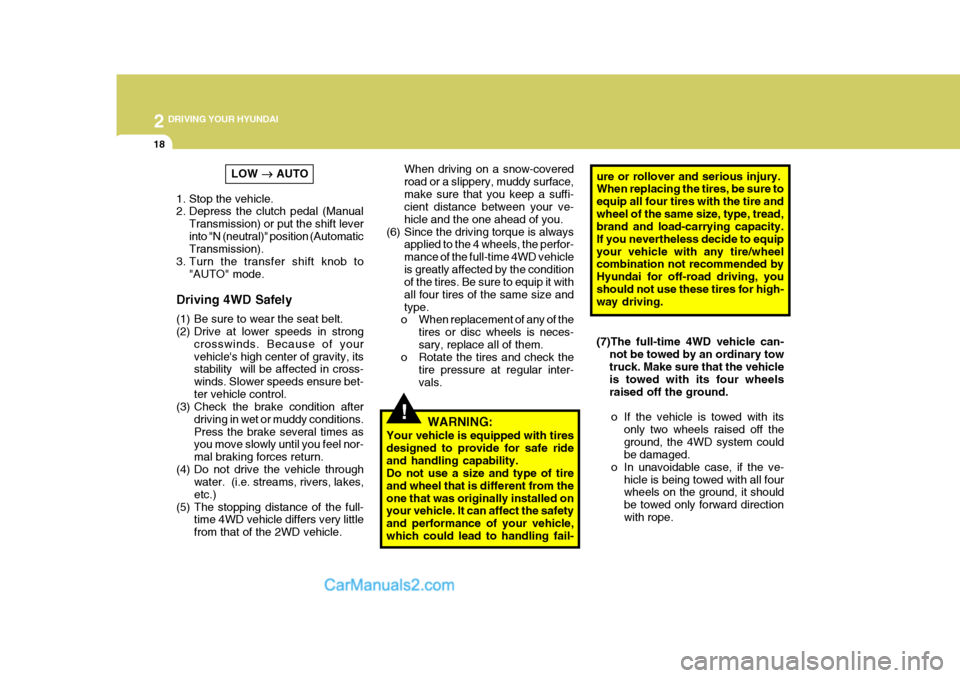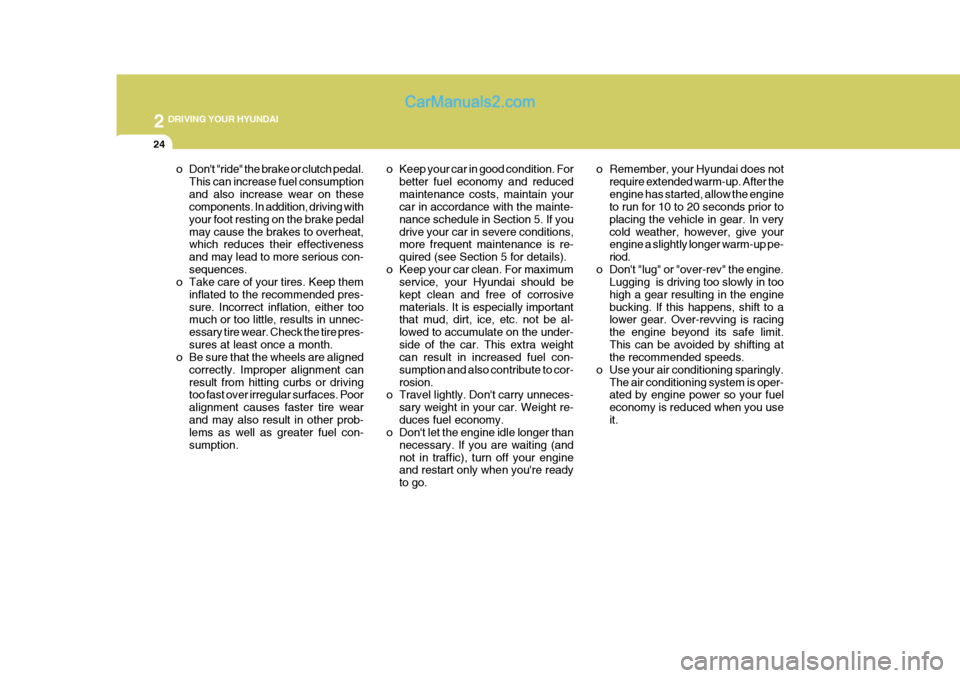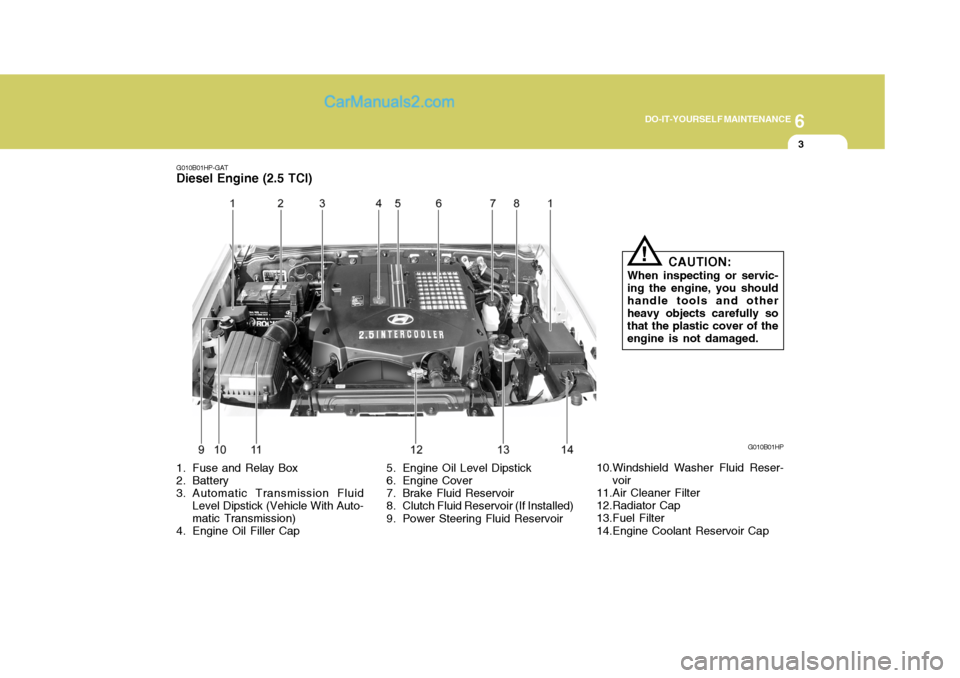2006 Hyundai Terracan clutch
[x] Cancel search: clutchPage 173 of 539

2 DRIVING YOUR HYUNDAI
18
!
When driving on a snow-covered road or a slippery, muddy surface,make sure that you keep a suffi- cient distance between your ve- hicle and the one ahead of you.
(6) Since the driving torque is always applied to the 4 wheels, the perfor-mance of the full-time 4WD vehicleis greatly affected by the condition of the tires. Be sure to equip it with all four tires of the same size andtype.
o When replacement of any of the
tires or disc wheels is neces-sary, replace all of them.
o Rotate the tires and check the
tire pressure at regular inter-vals. (7)The full-time 4WD vehicle can-
not be towed by an ordinary towtruck. Make sure that the vehicle is towed with its four wheels raised off the ground.
o If the vehicle is towed with its only two wheels raised off theground, the 4WD system could be damaged.
o In unavoidable case, if the ve-
hicle is being towed with all fourwheels on the ground, it should be towed only forward directionwith rope.
WARNING:
Your vehicle is equipped with tiresdesigned to provide for safe rideand handling capability. Do not use a size and type of tire and wheel that is different from theone that was originally installed on your vehicle. It can affect the safety and performance of your vehicle,which could lead to handling fail-ure or rollover and serious injury. When replacing the tires, be sure to equip all four tires with the tire andwheel of the same size, type, tread, brand and load-carrying capacity. If you nevertheless decide to equipyour vehicle with any tire/wheel combination not recommended by Hyundai for off-road driving, youshould not use these tires for high- way driving.
LOW
��
��
� AUTO
1. Stop the vehicle.
2. Depress the clutch pedal (Manual Transmission) or put the shift lever into "N (neutral)" position (Automatic Transmission).
3. Turn the transfer shift knob to
"AUTO" mode.
Driving 4WD Safely
(1) Be sure to wear the seat belt.
(2) Drive at lower speeds in strong crosswinds. Because of yourvehicle's high center of gravity, its stability will be affected in cross- winds. Slower speeds ensure bet-ter vehicle control.
(3) Check the brake condition after
driving in wet or muddy conditions.Press the brake several times as you move slowly until you feel nor- mal braking forces return.
(4) Do not drive the vehicle through water. (i.e. streams, rivers, lakes,etc.)
(5) The stopping distance of the full- time 4WD vehicle differs very littlefrom that of the 2WD vehicle.
Page 179 of 539

2 DRIVING YOUR HYUNDAI
24
o Remember, your Hyundai does notrequire extended warm-up. After the engine has started, allow the engine to run for 10 to 20 seconds prior to placing the vehicle in gear. In verycold weather, however, give your engine a slightly longer warm-up pe- riod.
o Don't "lug" or "over-rev" the engine. Lugging is driving too slowly in toohigh a gear resulting in the enginebucking. If this happens, shift to a lower gear. Over-revving is racing the engine beyond its safe limit.This can be avoided by shifting at the recommended speeds.
o Use your air conditioning sparingly. The air conditioning system is oper-ated by engine power so your fuel economy is reduced when you useit.
o Keep your car in good condition. For
better fuel economy and reducedmaintenance costs, maintain your car in accordance with the mainte- nance schedule in Section 5. If youdrive your car in severe conditions, more frequent maintenance is re- quired (see Section 5 for details).
o Keep your car clean. For maximum service, your Hyundai should bekept clean and free of corrosivematerials. It is especially important that mud, dirt, ice, etc. not be al- lowed to accumulate on the under-side of the car. This extra weight can result in increased fuel con- sumption and also contribute to cor-rosion.
o Travel lightly. Don't carry unneces-
sary weight in your car. Weight re-duces fuel economy.
o Don't let the engine idle longer than
necessary. If you are waiting (andnot in traffic), turn off your engine and restart only when you're ready to go.
o Don't "ride" the brake or clutch pedal.
This can increase fuel consumptionand also increase wear on these components. In addition, driving with your foot resting on the brake pedalmay cause the brakes to overheat, which reduces their effectiveness and may lead to more serious con-sequences.
o Take care of your tires. Keep them
inflated to the recommended pres-sure. Incorrect inflation, either too much or too little, results in unnec- essary tire wear. Check the tire pres-sures at least once a month.
o Be sure that the wheels are aligned
correctly. Improper alignment canresult from hitting curbs or driving too fast over irregular surfaces. Poor alignment causes faster tire wearand may also result in other prob- lems as well as greater fuel con- sumption.
Page 210 of 539

5
VEHICLE MAINTENANCE REQUIREMENTS
7
F030C08HP-GAT R : Replace I : Inspect and, after inspection, clean, adjust, repair or replace if necessary
Note: (1) FOR EVERY 24 MONTHS OR 45,000 KM, WHICHEVER OCCURS FIRST : "R" DESCRIPTION
GENERAL MAINTENANCE COOLING SYSTEM COOLANT MANUAL TRANSMISSION OIL AUTOMATIC TRANSMISSION FLUID BRAKE HOSES AND LINES BRAKE FLUID, CLUTCH FLUID REAR BRAKE DRUMS/LININGS, PARKING BRAKE BRAKE PADS, CALIPERS AND ROTORS EXHAUST PIPE AND MUFFLER SUSPENSION MOUNTING BOLTS STEERING GEAR BOX, LINKAGE & BOOTS/ LOWER ARM BALL JOINT, UPPER ARM BALL JOINT POWER STEERING PUMP AND HOSES DRIVE SHAFTS AND BOOTS AIR CONDITIONING REFRIGERANT TRANSFER CASE OIL AXLE GEAR OIL PROPELLER SHAFT CLEAN, BOLT RETIGHTEN AIR CONDITIONER FILTER (For Evaporator and Blower Unit)
NO.
1
2 3 4 5 6 7 89
1011 12 1314 15 1617 18
120
96
I
R I I I I I I I I I II I I I I I
R
105
84
I I I I I I I I I I II I I
R R
90 72
I
R I
R II I I I I I II I I I I I
R
7560
I I I I I I I I I I II I I I
R
60 48
I
R II I I I I I I I II I I I
R
I
R
4536
I I I I I I I I I I II I I I
R
30 24
I
R II I I I I I I I II I I I I I
R
1512
I I I I I I I I I I II I I
R R
KILOMETERS X 1000 MONTHS
European Community Only Except European Community
See Note (1)GASOLINE ENGINE DIESEL ENGINE
hpflene-5.p65
3/9/2005, 1:38 PM
7
Page 222 of 539

5
VEHICLE MAINTENANCE REQUIREMENTS
7
F030C08HP-GAT R : Replace I : Inspect and, after inspection, clean, adjust, repair or replace if necessary
Note: (1) FOR EVERY 24 MONTHS OR 45,000 KM, WHICHEVER OCCURS FIRST : "R" DESCRIPTION
GENERAL MAINTENANCE COOLING SYSTEM COOLANT MANUAL TRANSMISSION OIL AUTOMATIC TRANSMISSION FLUID BRAKE HOSES AND LINES BRAKE FLUID, CLUTCH FLUID REAR BRAKE DRUMS/LININGS, PARKING BRAKE BRAKE PADS, CALIPERS AND ROTORS EXHAUST PIPE AND MUFFLER SUSPENSION MOUNTING BOLTS STEERING GEAR BOX, LINKAGE & BOOTS/ LOWER ARM BALL JOINT, UPPER ARM BALL JOINT POWER STEERING PUMP AND HOSES DRIVE SHAFTS AND BOOTS AIR CONDITIONING REFRIGERANT TRANSFER CASE OIL AXLE GEAR OIL PROPELLER SHAFT CLEAN, BOLT RETIGHTEN CLIMATE CONTROL AIR FILTER (For Evaporator and Blower Unit)
NO.
1
2 3 4 5 6 7 89
1011 12 1314 15 1617 18
120
96
I
R I I I I I I I I I II I I I I I
R
105
84
I I I I I I I I I I II I I
R R
90 72
I
R I
R II I I I I I II I I I I I
R
7560
I I I I I I I I I I II I I I
R
60 48
I
R II I I I I I I I II I I I
R
I
R
4536
I I I I I I I I I I II I I I
R
30 24
I
R II I I I I I I I II I I I I I
R
1512
I I I I I I I I I I II I I
R R
KILOMETERS X 1000 MONTHS
European Community Only Except European Community
See Note (1)GASOLINE ENGINE DIESEL ENGINE
Page 228 of 539

Engine Compartment .................................................... 6-2
General Checks ........................................................... 6-5
Checking the Engine Oil .............................................. 6-6 Changing the Engine Oil and Filter ............................. 6-10
Checking and Changing the Engine Coolant ..............6-11
Changing the Air Cleaner Filte r ...................................6-14
Checking the Transmission Oil (Manual)................... 6-17
Checking the Transmission Fluid (Automatic)............6-18
Checking the Brakes .................................................. 6-21
Checking the Clutch Fluid ........................................... 6-22
Air Conditioning Care .................................................. 6-23
Changing the Climate Control Air Filter .. ....................6-24
Checking Drive Belts .................................................. 6-27
Checking and Replacing Fuses ..................................6-28
Checking The Battery ................................................. 6-31
Checking The Electric Cooling Fans ..........................6-33
Power Steering Fluid Level ......................................... 6-33
Fuel Filter ..................................................................... 6-34
Replacement of Headlight Bulbs ................................. 6-38
Headlight Aiming Adjustment ...................................... 6-39
Bulb Wattages ............................................................. 6-42
Fuse Panel D escription ............................................... 6-43
DO-IT-YOURSELF MAINTENANCE
6
6
Page 230 of 539

6
DO-IT-YOURSELF MAINTENANCE
3
G010B01HP-GAT
Diesel Engine (2.5 TCI)
G010B01HP
1. Fuse and Relay Box
2. Battery
3. Automatic Transmission Fluid Level Dipstick (Vehicle With Auto- matic Transmission)
4. Engine Oil Filler Cap 5. Engine Oil Level Dipstick
6. Engine Cover
7. Brake Fluid Reservoir
8. Clutch Fluid Reservoir (If Installed)
9. Power Steering Fluid Reservoir
10.Windshield Washer Fluid Reser-
voir
11.Air Cleaner Filter
12.Radiator Cap
13.Fuel Filter
14.Engine Coolant Reservoir Cap CAUTION:
When inspecting or servic- ing the engine, you shouldhandle tools and other heavy objects carefully so that the plastic cover of theengine is not damaged.
!
Page 232 of 539

6
DO-IT-YOURSELF MAINTENANCE
5GENERAL CHECKS
G020A01HP-GAT
Engine Compartment
The following should be checked regu- larly:
o Engine oil level and condition
o Transmission fluid level and condi- tion
o Brake fluid level
o Clutch fluid level
o Engine coolant level
o Windshield washer fluid level
o Accessory drive belt condition
o Engine coolant hose condition
o Fluid leaks
(on or below components)
o Power steering fluid level
o Battery condition
o Air filter condition G020B01A-AAT
Vehicle Exterior
The following should be checked
monthly:
o Overall appearance and condition
o Wheel condition and wheel nut torque
o Exhaust system condition
o Light condition and operation
o Windshield glass condition
o Wiper blade condition
o Paint condition and body corrosion
o Fluid leaks
o Door and hood lock condition
o Tire pressure and condition
(including spare tire) o Defroster, heating system operation
(and air conditioning, if installed)
o Steering operation and condition
o Mirror condition and operation
o Turn signal operation
o Accelerator pedal operation
o Brake operation, including parking brake
o Manual transmission operation, in- cluding clutch operation
o Automatic transmission operation, including "Park" mechanism opera- tion
o Seat control condition and opera- tion
o Seat belt condition and operation
o Sun visor operation If you notice anything that does not operate correctly or appears to befunctioning incorrectly, inspect it care- fully and seek assistance from your Hyundai dealer if service is needed.
G020C01HP-GAT
Vehicle Interior
The following should be checked each
time when the vehicle is driven:
o Lights operation
o Windshield wiper operation
o Horn operation
Page 249 of 539

6 DO-IT-YOURSELF MAINTENANCE
22
!
G120E02A-AAT
Adding Brake Fluid
WARNING:
Handle brake fluid carefully. It can damage your vision if it gets into your eyes. Use only DOT 3 or DOT4 specification fluid from a sealed container. Do not allow the fluid can or reservoir to remain openany longer than required. This will prevent entry of dirt and moisture which can damage the brake sys-tem and cause improper opera- tion.
To add brake fluid, first wipe away any
dirt, then unscrew the fluid reservoircap. Slowly pour the recommended fluid into the reservoir. Do not overfill.Carefully replace the cap on the reser- voir and tighten.
CHECKING THE CLUTCH FLUID
!
G130A01A-AAT
To Check the Clutch Fluid The clutch fluid level in the master
cylinder should be checked when performing other under hood services. The system should be checked for leakage at the same time. Check tomake certain that the clutch fluid level is always between the "MAX" and "MIN" level markings on the fluid res-ervoir. Fill as required. Fluid loss indi- cates a leak in the clutch system which should be inspected and re-paired immediately. Consult your Hyundai dealer. G130B02A-AAT
To Replace the Fluid
Recommended brake fluid conforming
to DOT 3 or DOT 4 specification shouldbe used. The reservoir cap must be fully tightened to avoid contaminationfrom foreign matter or moisture.
NOTE: Do not allow any other liquids to
contaminate the brake fluid. Seal damage will result.
WARNING:
Use caution when handling brake
fluid. It can damage your vision ifyou get it in your eyes. It will also damage your vehicle’s paint if spilled on it and not removed im-mediately.
HHP5016